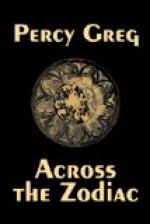We now came to the entrance of a vast enclosure bordering on the river, the greatest fish-breeding establishment on this continent, or indeed in this world. One of its managers courteously showed me over it. It is not necessary minutely to describe its arrangements, from the spawning ponds and the hatching tanks—the latter contained in a huge building, whose temperature is preserved with the utmost care at the rate found best suited to the ova—to the multitude of streams, ponds, and lakes in which the different kinds of fish are kept during the several stages of their existence. The task of the breeders is much facilitated by the fact that the seas of Mars are not, like ours, salt; and though sea and river fish are almost as distinct as on Earth, each kind having its own habitat, whose conditions are carefully reproduced in the breeding or feeding reservoirs, the same kind of water suits all alike. It is necessary, however, to keep the fishes of tropical seas and streams in water of a very different temperature from that suited to others brought from arctic or sub-arctic climates; and this, like every other point affecting the natural peculiarities and habits of the fish, is attended to with minute and accurate care. The skill and science brought to bear on the task of breeding accomplish this and much more difficult operations with marvellous ease and certainty.
On one of the buildings I observed one of the most remarkable, largest, and most complete timepieces I had yet seen; and I had on this occasion an opportunity of examining it closely. The dial was oblong, enclosed in a case of clear transparent crystal, somewhat resembling in form the open portion of a mercurial barometer. At the top were three circles of different colours, divided by twelve equidistant lines radiating from the centres and subdivided again and again by the same number. Exactly at the uppermost point of each was a golden indicator. One of these circles marked the temperature, graduated from the lowest to the highest degree ever known in that latitude. Another indicated the direction of the wind, while the depth of colour in the circle itself, graduated in a manner carefully explained to me, but my notes of which are lost, showed the exact force of the atmospheric current. The third served the purpose of a barometer. A coloured band immediately below indicated by the variations of tint the character of the coming weather. This band stretched right across the face; below it were figures indicating the day of the year. The central portion of the face was occupied by a larger circle, half-green and half-black; the former portion representing the colour of the daylight sky, the latter emblematic of night. On this circle the Sun and the planets were represented by figures whose movement showed exactly the actual place of each in the celestial sphere. The two Moons were also figured, their phases and position at each moment being accurately presented to the eye. Around




